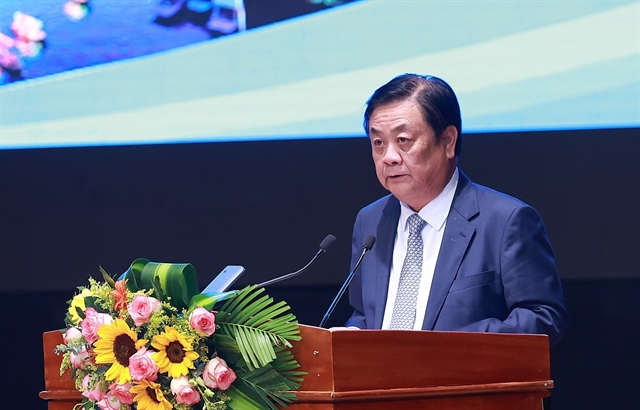
|
| Minister of Agriculture and Rural Development Lê Minh Hoan. VNA/VNS Photo |
Minister of Agriculture and Rural Development Lê Minh Hoan discussed the performance of Việt Nam’s agriculture sector in 2023 and its development directions for 2024 in an interview with the Vietnam News Agency (VNA).
Agriculture has been recognised as a bright spot in the economic development of 2023. What measures have been taken by the Ministry of Agriculture and Rural Development (MARD) to ensure its growth?
Economic and market intelligence played an important part in the sector’s growth last year. Traditionally, farmers focused on how to improve production, but higher yields did not always translate to increased income. As prices fluctuate, they may produce more but gain less.
Our markets have become more complex and challenging. Farmers need to gain a better understanding of consumers’ characteristics. Some agricultural products are consumed in China but not in Europe. Or a product may sell well in the US but not in Europe. We used to view the market merely as a place for buying and selling; now, it is also a consumer culture.
Even within the 27 European countries, consumer trends vary. When we enter a market, it’s crucial to shift the production focus for farmers and to align production objectives with the market’s standards.
Our agricultural products have more than proven Vietnamese farmers’ ability to meet even the most stringent requirements. For instance, Vietnamese rice has entered markets like China, Japan and the EU, all of which are demanding markets with tightening technical regulations and food safety requirements.
Sometimes it’s not just about supply and demand. The success of the sector also depends on how the global markets view the country and their confidence in Vietnamese agricultural products. This is something we have been working on in recent years, to convey to the world the message that Việt Nam is a reliable, transparent, responsible and sustainable agricultural producer.
What measures had been taken by MARD to help Vietnamese farmers capitalise on the world’s higher-than-usual demand for food in 2023?
The first step we took was to reorganise the country’s agricultural production because it was fragmented, with too many small, independent farming operations. Too many farmers participating in a single sector could lead to conflicts. That’s why the most crucial step was to reorganise the structure of the sector and production, establish markets and create links between farmers and businesses to reduce the possibility of market breakdowns.
We view farmers and businesses are two ends of the sector. One represents input, and the other represents output; one involves production, and the other involves the market. Sustainability is only ensured when these two entities work together.
Businesses must proactively provide stable raw materials, and support farmers with seeds, and cultivation processes. Businesses themselves should move away from a trading mindset, as it can disrupt the market. There needs to be a balance of interests between farmers and businesses, which will allow both to thrive.
Should Việt Nam continue its shift from a production-focused model to an economic, green, and circular agricultural model?
Sustainable agriculture is a vital trend to which we must adapt. For instance, in Tứ Kỳ District in northern Hải Dương Province, farmers have produced rice, frogs and fish, creating three layers of value. This allowed them to earn more from selling frogs than rice, but without rice, they wouldn’t have these two products. Similarly, in the rice-shrimp or rice-fish models in the southern provinces of Bạc Liêu and Cà Mau, farmers are moving towards an ecological agriculture system.
As input costs continued to rise, these models also helped farmers reduce expenses. Even if prices don’t increase, when costs decrease, farmers’ income still rise. The sector needs to promote such models, focusing on circular, green and eco-friendly agriculture in harmony with nature. In my opinion, all changes are challenging, but refusing to change would put us in an even more difficult position down the road.
What are MARD’s mission objectives in 2024?
Our key priorities this year include the continuous promotion and application of economic intelligence and the transition of the sector from a production-focused model to an economic and sustainability-focused model.
In addition, we will further explore solutions to generate more value per unit of agricultural land. We must start seeing that agriculture is not just about farming. There are business models that allow the integration of numerous other economic sectors with agricultural activities, which in turn, can produce additional value for all players.
For instance, agricultural tourism is a promising model. The Sa Đéc flower village in the southern province of Đồng Tháp has taken measures to modify its production to create tourist destinations. If implemented successfully, the benefits can be substantial. There have been successful cases in which farmers reported significant income increases. VNS
- Reduce Hair Loss with PURA D’OR Gold Label Shampoo
- Castor Oil Has Made a “Huge” Difference With Hair and Brow Growth
- Excessive hair loss in men: Signs of illness that cannot be subjective
- Dịch Vụ SEO Website ở Los Angeles, CA: đưa trang web doanh nghiệp bạn lên top Google
- Nails Salon Sierra Madre
 VnExpress News The News Gateway of Vietnam
VnExpress News The News Gateway of Vietnam




